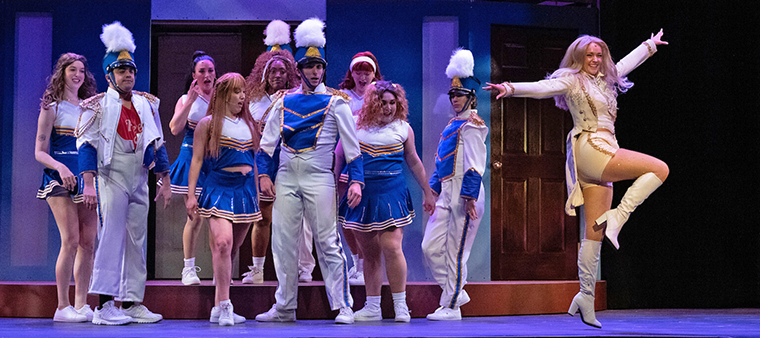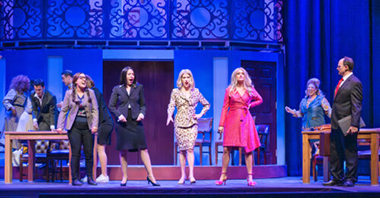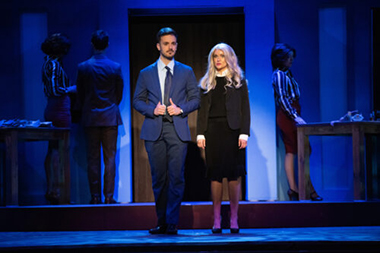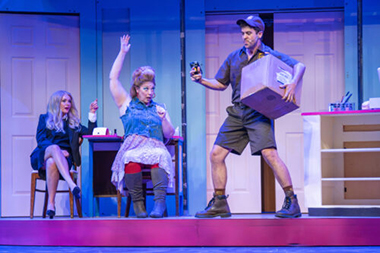
Photographer: GREGORY REED, MFA
Becca Andrews as Elle Woods with the ensemble in Actors' Playhouse production of "Legally Blonde."
While it may sound cliched, “Don’t judge a book by its cover” is a useful reminder that first impressions are not always the most accurate ones. This is one of the messages in “Legally Blonde,” but it also applies to the show itself.
Upon a brief, first glance, “Legally Blonde” may seem to be simply a sugary tale with empty calories about the adventures of a stereotypical blonde. But look deeper, and you will discover a piece with substance. Indeed, “Legally Blonde” has something to say about first impressions, stereotypes, pursuing your dreams, being the best version of yourself, integrity, friendship, and feminism.
Thoughts such as these may cross your mind as you experience the live stage musical adaptation of “Legally Blonde,” set during the early 2000s in California and Massachusetts. The live show is based on a novel with the same title, and the 2001 film starring Reese Witherspoon, also titled “Legally Blonde.”
The live adaptation, which is faithful to its source material yet branches out on its own, is playing through Sunday, Feb. 25 at Actors’ Playhouse at the Miracle Theatre in Coral Gables.
The company, which consistently produces quality professional musical theater, has delivered another hit with its vibrant and mostly believable mounting of “Legally Blonde: The Musical.”
Under Artistic Director David Arisco’s astute direction, the large cast succeeds at achieving deft comic timing and finding layers in their characters. The cast features a mix of triple-threat performers with whom South Florida theatergoers may be familiar and talented new faces. In addition, patrons may also recognize the gifted behind-the-scenes artists.

Photographer: GREGORY REED
Jessica Brooke Sanford, Hana Slevin, Stephanie White, Becca Andrews, Heather Jane Rolff, and Michael Dean Morgan in Actors' Playhouse production of "Legally Blonde."
Two faces you probably won’t recognize, but will adore, belong to live dogs Cha Cha and Tony. They portray Bruiser and Rufus, respectively. The canines are trained by well known stage animal trainer William Berloni.
To Actors’ Playhouse’s credit, live musicians instead of recorded tracks accompany the actors in song. Band members energetically play instruments such as drums, guitar, trombone, reed, and keyboard without drowning out the performers.
Becca Andrews, a performer with a honeyed voice, is making her Actors’ Playhouse debut as the blonde Elle Woods, although she has played the part six times previously. She is a sorority president and fashion merchandising major with a 4.0 GPA who receives a proverbial punch in the gut when her boyfriend, Warner Huntington III (Alexander Zenoz) dumps her in favor of his more “serious” brunette ex-girlfriend, Vivienne Kensington. After all, Huntington has a family reputation to uphold. And, so, he is headed to Harvard Law School, where he will study before hopefully making a name for himself.
“Since I was two or three, my life was planned out neat; I’d get my law degree, yeah, and then win my senate seat,” Huntington sings to Woods, clearly and simply laying out his purpose in life.

Photographer: GREGORY REED, MFA
Becca Andrews as Elle Woods holds Cha Cha as her pet, Bruiser, while from left are: Stephen Christopher Anthony, A.J. Cola, and Diego Klock-Perez.
Woods, obviously heartbroken, feels she must do something to make Huntington take her seriously. She figures that if she also attended Harvard Law School, Huntington would view her as much more than a stereotypical blonde. With that in mind, our heroine heads to Harvard Law School after performing well on the Law School Admission Test. In addition, she delivers a killer admissions essay (in the form of an energetic song and dance number, of course, reinforcing Woods’ charisma).
Eventually, Woods discovers that Huntington is not the man she thought he was. And the other characters learn that there is more to Woods than her blonde hair.
The 2007 live adaptation, which won the Laurence Olivier Award for Best New Musical (Britain’s equivalent of Broadway’s Tonys), is an improvement over the charming movie. For instance, the end of the musical reinforces the show’s feminist theme. Specifically, it shows Woods taking command of her future as she asks Emmett Forrest (Stephen Christopher Anthony) to marry her. Contrastingly, in the film, an epilogue merely indicates that Forrest proposed to Woods on graduation night.

Photographer: GREGORY REED, MFA
Stephen Christopher Anthony as Emmett Forrest and Becca Andrews as Elle Woods in Actors' Playhouse's "Legally Blonde."
Under Arisco’s smart direction, we strongly sense solidarity between the characters. The director positions the women close together to suggest unity. Also, the cast executes associate director and choreographer Sarah Crane’s physically demanding moves with synchronicity. This also helps reinforce unity between the characters.
As Woods, Andrews flashes a sunny smile. In addition, the performer imbues her character with charm, a bubbly demeanor, and passion. But to her credit, Andrews never lets Woods become a caricature or stereotype. Clearly, Andrews’ Woods is a smart, radiant young woman with sincere feelings and vulnerability. For example, she is clearly emotionally hurt after Huntington breaks up with her and after Callahan hits on her.

Photographer: GREGORY REED, MFA
Becca Andrews as Elle Woods and Heather Jane Rolff's Paulette with Diego Klock Perez as Kyle the UPS guy.
Speaking of Callahan, a wide-eyed Michael Dean Morgan portrays him with a sharp voice and a commanding aura. In fact, as Morgan forcefully, yet naturally plays the professor and attorney, there is a ruthless streak to him. One of the show’s songs, “Blood in the Water” helps accentuate his cutthroat nature.
“Law school is a waste, oh yes, unless you acquire a taste for blood in the water,” Morgan’s Callahan sings. “Dark and red and raw, you’re nothing until the thrill of the kill becomes your only law.”
In the film, one of Woods’ professors is a woman. While she asks Woods to leave her class one day after the young woman reveals that she didn’t do the assigned reading, the professor ends up being an advocate for Woods. Both are strong female characters. So, it is disappointing that the musical adaptation’s librettist, Heather Hach, left the female professor out of the live show.
“So would you please withdraw, and if you return be ready to learn,” he sings. “Or, is that unfair? Oh wait, I don’t care! That’s just how I rule in life as in school.”
In a strong contrast to Morgan’s harsh Callahan, Alexander Zenoz gives his Huntington a gentle disposition and a likability that endears us to him, at least in the beginning. Zenoz’s appropriate acting choices make it obvious why someone would fall in love with Huntington and want to marry him. And credit Zenoz for his choices as Huntington when he gently breaks it to Woods that he is leaving her.

Photographer: GREGORY REED, MFA
Stephanie White as fitness queen Brook Wyndham, center, is the center of attention.
Meanwhile, Anthony lends Forrest drive, intelligence, and seriousness, one of Woods’ classmates at Harvard who is somehow also licensed as an attorney. Anthony imbues Forrest with compassion, especially toward Woods. Certainly, that quality makes us understand why Woods feels drawn to the man.
As Kensington, Hana Slevin undergoes a seamless transformation from a serious, snotty law student to a sympathetic character who befriends Woods at the end.
Other cast standouts include Heather Jane Rolff. She endows Paulette with an endearing awkwardness, kindness, and upbeat demeanor. In addition, she demonstrates strong chemistry with Woods. That is important because the two form a tight, convincing bond in Actors’ Playhouse’s production. Paulette also grows close to Kyle the UPS Guy (Diego Klock-Perez, demonstrating some nifty moves).
While the performers portraying lead characters generally succeed, a few of the actors in minor roles could use work. Faythe Kelly needs to lend the judge in the murder trial more gravitas. Also, the actors portraying Harvard’s admissions officers tend to overact, as does one performer portraying a policeman.
Stephanie White fares better as Brooke Wyndham, a fitness guru accused of murder. The character hesitates to provide her alibi due to embarrassment, and White credibly conveys a sense of shame.
In the musical, unlike in the film, Woods’ friends from her sorority comprise a Greek chorus.
“Elle, this is a tragedy,” one of the women says, referring to Huntington breaking up with Woods. “And every tragedy needs a Greek Chorus.”
We’re here to help,” another chorus member adds.
“But we’re not actually here, we’re in your head,” yet another chorus member chimes in.
The Greek Chorus members appear throughout the show, commenting on the action and supporting Woods. The actors portraying chorus members are appropriately vivacious.

Photographer: GREGORY REED, MFA
Michael Dean Morgan as the ruthless and commanding Professor Callahan.
These actors enter the action from the audience seating area at times. This is a useful directorial decision that can, for instance, reinforce the relevance of a show to the current time.
Behind the scenes, Brandon Newton has created a striking set with realistic-looking detail and mostly appropriate colors. For instance, pink is the predominant color in the settings located in Woods’ home in California. For scene changes, the set seamlessly rotates to reveal other locales, such as the halls of Harvard. Colors such as blue and brown contrast nicely with pink. Yet, curiously, touches of the latter color adorn Newton’s depiction of Harvard as well. It would have seemed more logical to reserve pink for locations such as Woods’ sorority house.
Costume designer Ellis Tillman’s clothes sport colors that befit the characters. For example, Woods dresses in pink and white and the prisoners wear orange.
Lighting designer Eric Nelson also uses appropriate hues such as red during the song, “Blood in the Water.” In addition, Nelson uses a variety of dimmed and bright lighting, depending on a scene’s mood.
Fans of the movie are probably happy that Hach is largely faithful to the film. Her witty and engaging book mixes nicely with Laurence O’Keefe and Nell Benjamin’s serviceable lyrics and mood-setting melodies.
While the libretto is generally strong, the film and the musical could have focused more on Woods and Huntington’s relationship. Had we spent more time with the couple and learned why they had grown so close, we might have felt more heartbroken, along with Woods, during the emotional breakup. Instead, the movie and the musical begin shortly before Woods believes that Huntington will propose to her at dinner.
Quibbles aside, “Legally Blonde” remains an invigorating, sweet treat with substance more than two decades after the film made its smash at the box office.
"Legally Blonde the Musical" runs through Sunday, Feb. 25 at Actors Playhouse at the Miracle Theatre, 280 Miracle Mile in Coral Gables. Showtimes are 8 p.m. Wednesday through Saturday, 3 p.m. Sunday (an additional matinee on Saturday, Feb. 10). Tickets cost $40, $55, $65, $75, $85; seniors 65 and older g et 10 percent off on weekdays. Students with valid student ID pay $15 for a rush ticket, available 15 minutes before a weekday performance. For tickets and more information, call (305) 444-9293 or go to www.actorsplayhouse.org.
 MAIN MENU
MAIN MENU

